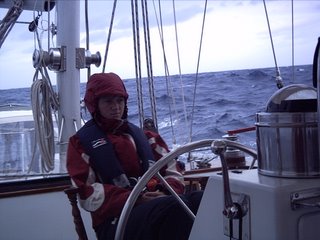Forecast Schmorcast

I wrote this last year after our delivery from New York City to Tortola. It was a wet, windy, bumpy, wild 9 day ride. As we slid off of wave after wave, shaking in our constantly sea salt soaked boots, I constructed the following text in my sleep deprived brain.
So, as we prepare for our departure next week, which we now hear will be following an offshore gale, I hope that our weather routers treat us well. Or at least err on the positive (read: dry) side of the forecast.
Guessing the forecast
I guess I have to be happy about the fact that we didn’t buddy boat. Then the stuff really would’ve hit the fan and we probably wouldn’t have even checked in with the routers. Cruisers are funny like that, and yes, I do consider myself a cruiser. Luckily we learned our lesson early about the lemming tendencies of “buddy boating.” It usually goes something like this. You and the other boat(s) crew listen to the weather or download data from NOAA for about a week and talk about the best day to head out as you sip your Pacifico, the little lime at the bottom of the bottle clunking around every time you make an exclamatory point. The beginning day of the burgeoning and elusive “weather window” that you have all settled on looms closer and everyone is still downloading and listening, but somehow discussing it over margaritas on the nights leading up to departure seems to make it seem more favorable than it really may be. “30 knots on the nose? My boat loves 30 knots! Now we’ll really get to test out those weeping chain-plates!” (High five across the table, upsetting the basket of chips). Or somehow talk about the system off to the east mysteriously ceases as the expectations for an on-time departure grows. Plans are made to meet so and so at such and such marina on specific dates and even actual hours, dinghies are hauled out of the water, fresh provisions and ice packed away, and sails hanked on to the forestay. No turning back now, even with ominously dark clouds marching across the horizon (oh, that, it’s just a squall. A little fresh water on the decks ain’t a bad thing, right? Besides, our ice is going to melt if we don’t leave this minute!) So off you and your buddy boat(s) go, under way at last and with a safety net. I mean, seriously, what can really go wrong if you have one or two other sailboats under 40 feet a few miles away? You talk on VHF, telling each other about the nasty lightening storms showing up on the radar and what do you know, on the other side of the dodger, but soon you have to switch to a predetermined frequency on the SSB at intervals of 6 hours to check in as the distance between the various boats inevitably increases over the days. But somehow you still feel safe as long as that voice is on the radio or a running light on the horizon is visible, even when the moon is blotted out by cumulonimbus or the driving rain momentarily disrupts your view of the building seas. If you had gone off “dangerously” by yourself, most likely you would have paid more attention to the weather faxes and reports and waited for the real, or at least more favorable, window a few days later. But as I well know, sometimes peer pressure gets the best of you.
So what’s the moral of the story for you and me? Do the homework. Always. Even if the guy on the 54’
Comments